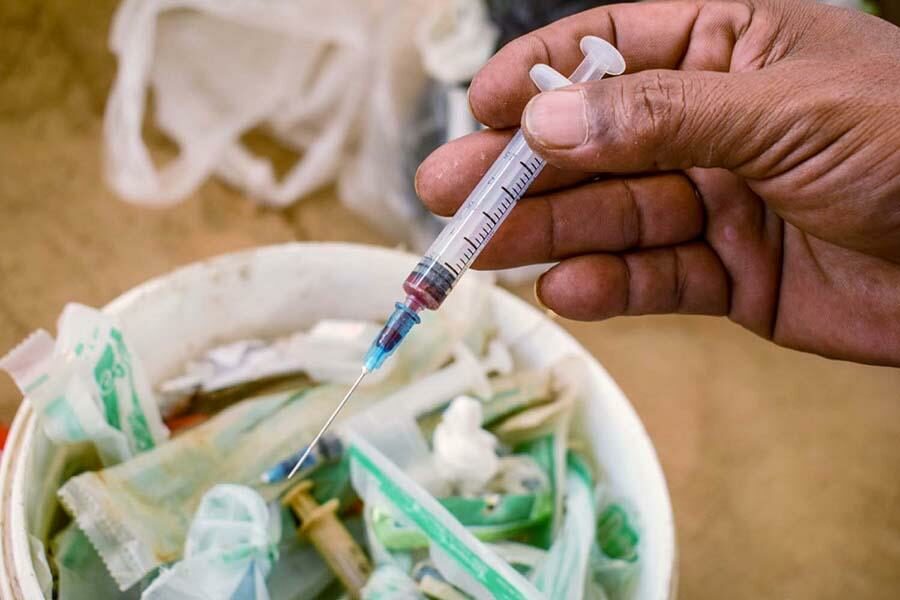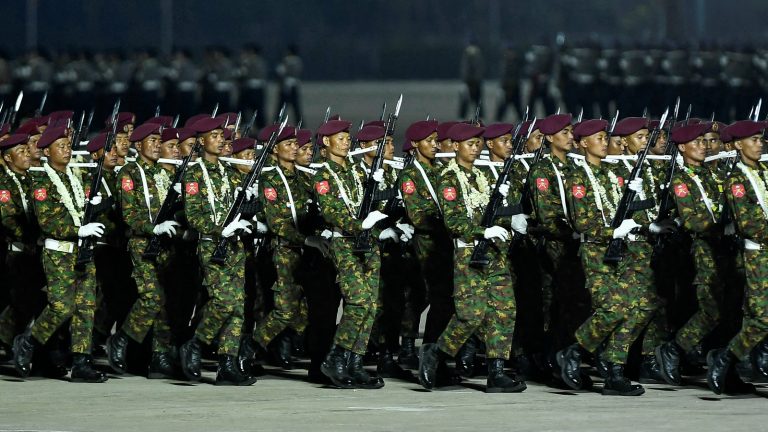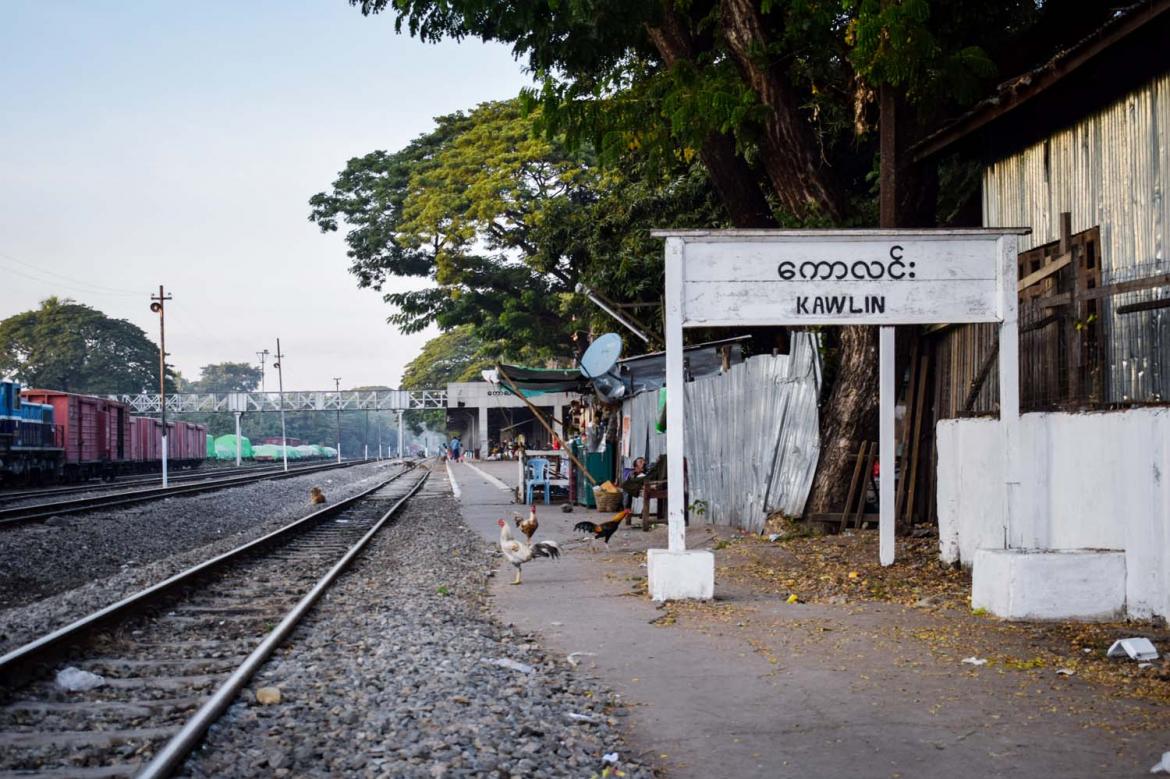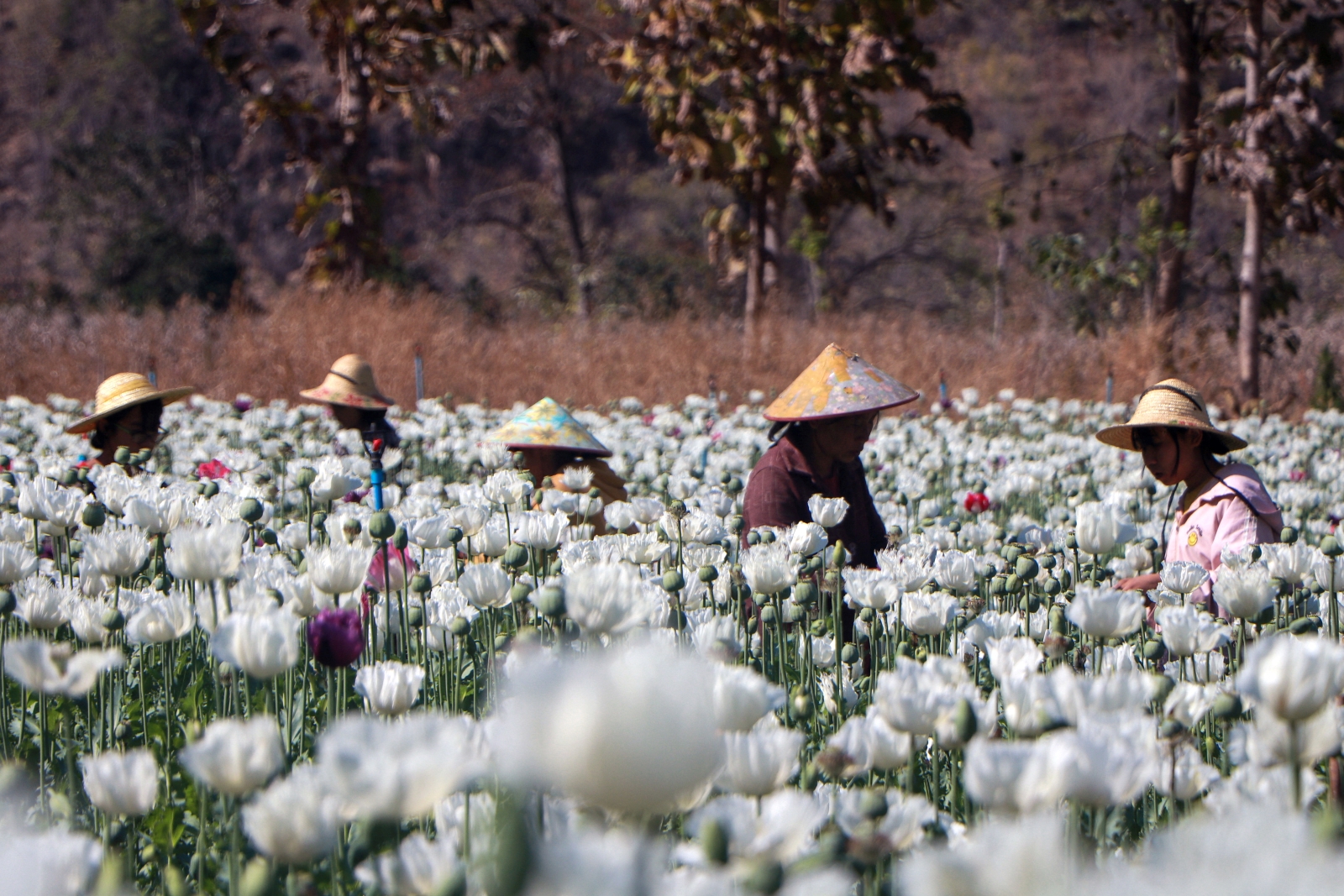With the breakdown of rule of law in Myanmar’s Dry Zone, resistance groups are taking drug enforcement into their own hands, but with limited resources and expertise, rehabilitation efforts often involve flogging and prison cells.
By FRONTIER
Early in the morning and late at night, residents of Kalay say drug users and dealers can be seen gathering at a football field in the town’s Tat Oo Thida ward.
“The people are injecting, snorting and smoking. I think it’s a result of the conflict,” said 24-year-old Ma Thiri Win Myint. She said people in the Sagaing Region town mostly use heroin, which typically comes as a pale yellow powder, sometimes mixing it with methamphetamines or other drugs.
“I know the People’s Defence Force and Kalay Police Service are trying to crack down on drugs, but they can only do it in their territory,” she said of anti-military forces who operate mostly in the surrounding countryside. “The drugs are instead coming from military territory. It’s like they [military and police] are ignoring the drug problem.”
The February 2021 military coup and crackdown on peaceful protests gave rise to armed resistance and a breakdown in the rule of law. Parts of Sagaing and Magway regions, in Myanmar’s central Dry Zone, have emerged as strongholds of anti-coup PDFs and have been wracked by intense conflict.
In some areas where the military has limited control, resistance groups have even formed their own police forces, like the KPS, typically founded by defecting officers. These groups are generally loyal to the parallel National Unity Government, appointed by elected lawmakers deposed in the coup.
Sagaing communities have long been afflicted by drug addiction but the situation appears to have worsened since the coup, partly thanks to a crash in prices caused by ramped-up production. Locals say people in the region can purchase a small amount of heroin starting as low as K500, while a methamphetamine or WY tablet goes for around K1,000, down from K6,000 before the military takeover.
PDFs in the area say the NUG has instructed them to take action against drug dealers – as well as users – under the Narcotic Drugs and Psychotropic Substances Law. But there are many ways, of varying severity and effectiveness, that action can be taken against users.
“We don’t want to detain substance users in a police cell, we want them to be rehabilitated and become good people again,” said Ko Aung Gyi, spokesperson for the KPS.
The reality, however, is that in an area with few resources, locking users in small cells is the go-to solution.
The KPS, which is officially recognised by the NUG and has two jurisdictions in the north and south of Kalay Township, says most of the cases it handles are drug related. The group says it aims to rehabilitate users while punishing dealers.
Aung Gyi said the latter have been given sentences of up to 10 years in prison by courts established under the NUG’s authority in the township, and that convicts are “held in police cells”.
Bo Cross, the deputy commander of a resistance group in Magway’s Myaing Township, said alleged drug dealers in Myaing are also subjected to physical punishment, even before a verdict is handed down, typically having their feet locked in wooden pillories before the trial. Afterwards, they are relocated to a different cell in a “conflict-free zone”.
But while users are typically spared imprisonment – despite the harsh sentences prescribed under the narcotic drugs law – their treatment by these resistance groups is nonetheless severe. KPS rehabilitation programmes often involve locking users in a small 10×10 foot wooden cell as part of a cold-turkey detox, and other comments by Aung Gyi indicate they do see drug use alone as a threat to society.
“When a user has no money to buy drugs, he will steal, and the next step will be murder. That’s why we need to arrest and punish them,” said Aung Gyi.
In other cases, resistance groups have admitted to physically abusing drug users.
Bo Cross said they punish drug users by flogging them 10 times. He added that most of the substance users detained by the Myaing PDF work in the township’s many oilfields.
When asked if flogging drug users was unethical, Bo Cross said he didn’t know, and that the group came up with the policy itself, without outside guidance.
“It is, in my opinion, the most effective technique to deal with drug users. We haven’t yet witnessed a second offence,” he said.
But a heroin user in Myaing, who claimed he was arrested, flogged and then released by the PDF in November last year, told Frontier he’s still using four months later.
“I’m trying to taper myself off heroin, but you understand how difficult it is to stop using quickly. I’m taking my time to stop using, and I’m being cautious not to get arrested again,” he said.
Medical experts and researchers also said physical punishments and forced detox are ineffective.
“Beating people or detaining them in small cells are ineffective methods. That could make the situation much worse,” said a psychiatrist who formerly worked at a state institution before joining the mass strike known as the Civil Disobedience Movement in defiance of the coup.
Dr Patrick Meehan, who has researched similar drug polices in neighbouring Kachin State, echoed the psychiatrist’s assessment.
“I would say that this kind of punishment has very little effect, beyond the immediate fear it creates, and is likely to be detrimental,” he said.
Meehan said physical punishment could discourage casual users but not those “facing real struggles with addiction”. He added that in Kachin, anti-drug campaigners realised these methods were ineffective when many users quickly returned to drugs after going through similar rehabilitation programmes.
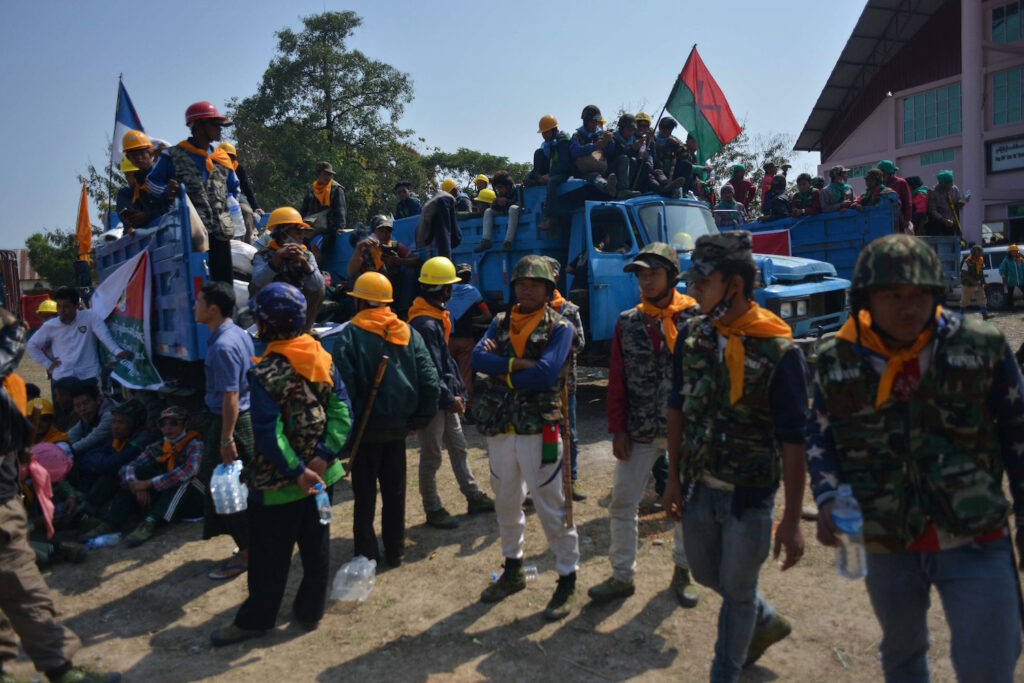
Parallels to Pat Jasan
Some of these Kachin-based campaigners were members of Pat Jasan, a Christian drug eradication movement that emerged in 2014 following the collapse of the ceasefire between the Kachin Independence Army and the Myanmar military three years before.
In a 2021 article for the International Journal of Drug Policy, Meehan and other Western and Myanmar scholars say Pat Jasan is connected to the KIA and Kachin churches, and is often one-dimensionally described as “drug vigilantism” without properly exploring its origins.
While the KIA has played a significant role in training and arming some PDFs in Sagaing, all the groups interviewed in the Dry Zone insisted that their drug policies were developed independently and organically, not under the KIA’s guidance.
The 2021 paper acknowledges that Pat Jasan drug raids have often involved “human rights violations”, including the forced detention of drug users, acts of violence and the destruction of property. It says this approach “clearly diverges radically… from evidence-based international harm reduction practices and norms”.
But it also emphasises the many difficulties of addressing drug abuse in a conflict zone with limited resources.
“It remains extremely challenging to build sustained community engagement, provide effective programme oversight, or maintain consistent supplies of methadone, or even to collect used syringes,” the paper says.
These challenges are also apparent in the Dry Zone, where resistance groups have limited infrastructure and access to medicine.
Aung Gyi from the KPS said it’s difficult to find methadone in Sagaing, a synthetic opioid designed to help addicts wean themselves off drugs. The group’s medical officer advised them to use counselling and behavioural therapy, but they lack qualified personnel to provide these services.
Moreover, while resistance groups have a budding parallel judiciary, they have limited facilities to hold prisoners or recovering users, and there are areas where they can’t enforce their laws.
Aung Gyi suspects some users are intentionally going into military-controlled territory, like Kalay’s Tat Oo Thida ward, to avoid detection while using drugs. “We aren’t in a position to arrest the substance users and dealers who are in military territory,” he said.

Pressure from the public
Meehan said parallel authorities in Kachin and Sagaing are in a difficult position, because they can’t “change the wider structural causes of widespread drug use” but are still expected by their constituencies to take action. This is exacerbated by the belief that the military is intentionally funnelling drugs into these communities.
“There is a widely-held perception amongst Kachin populations that the ease of access to drugs and the spread of drug harms has been an intentional strategy adopted by the Myanmar army against the Kachin people,” the 2021 paper says.
This perception appears now to be shared by people in the Dry Zone.
“Now that the junta rules the country, they often target young people to ruin their lives, and the weapon they use is drugs,” said Myaing resident Ko Than Nyaing.
However, Meehan said the military “benefits from the drug trade without directly orchestrating it” and has close links to many drug-trafficking organisations, including military-backed militias. He said many army units also “set up protection rackets” where they take money from drug traffickers to fund their “day-to-day operational costs”.
He said while some may believe the military is directly behind the drug trade, others see the trade “as emblematic of a political and economic model that has been hugely destructive”.
The vicious cycle of military power, conflict and drugs has only got worse since the coup.
“The coup has intensified a set of long-standing drivers of drug production, trade and drug use,” Meehan said, explaining that both law enforcement and more socially oriented community anti-drug movements have declined.
He said that “links between the shadow economy and war economy have become even stronger”, while certain industries commonly associated with drug use, like mining, have seen a surge in activity.
U Aye Hlaing, the military regime’s social welfare minister for Sagaing, acknowledged to BBC Burmese in January that security forces are limited in the region by safety concerns, but insisted police are still investigating and taking action on drug cases.
According to a recent report by the United Nations Office on Drugs and Crime, opium cultivation increased in Myanmar last year compared to 2021, the first yearly rise since 2014.
“In the first full season opium survey after the military takeover, poppy cultivation is estimated to have increased by 33% compared to the previous season,” the report said.
Against this backdrop, it’s little wonder that Dry Zone residents are clamouring for action from resistance groups that present themselves as a more responsible and viable alternative to the military’s local administrations.
Meehan said some people may see physical punishments like flogging as “a way of doing something to try to discourage drug use” that is “also less destructive for young people than prison”.
The heroin user who was flogged in Myaing agreed that it was “better than prison”. “If I’d been arrested by the authorities, I would have faced at least seven years in prison,” he said.
Meanwhile, residents like Than Nyaing seem satisfied with this approach, even if experts say it’s ineffective. He said communities in the Dry Zone should be thanking the PDFs.
“Young people are terrified of PDFs when it comes to drugs, and I feel like young people are now staying away from drugs,” he said.


